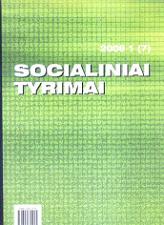Statistical Analysis of the Relation between Polluted Wastewater and Water Amounts Used for Country’s Needs
Statistical Analysis of the Relation between Polluted Wastewater and Water Amounts Used for Country’s Needs
Author(s): Povilas ŠukysSubject(s): Social Sciences
Published by: VšĮ Šiaulių universiteto leidykla
Keywords: Consumers of water; polluted wastewater; relation of consumption and wastewater.
Summary/Abstract: The objective of the paper was to evaluate statistically the contribution of economy spheres using water into the formation of polluted wastewater as well as to highlight the problems of water sector for further analysis. In Lithuania the main consumer of water is energetics that uses up to 94% of total consumed water amount. In 2004, for non-electricity puposes 224.8 mill. m³ of water were used for other purposes: 44.2% for domestic sector, 33.1% for fishery ponds, 21.5% for industry, 0.7% for agriculture, 1.2% for other needs. Compared to the data selected a decade ago, during the last years 2 times less amounts of water were used in domestic sector; in fishery and industry sectors water consumption decreased 1.55 and 1.4 times respectively. Consumption of potable water increased almost twice (from 8-9 to 17-20 mln.m³). During the study period total amount of polluted wastewater was constantly decreasing, on the average 26 mln.m³ per year (from 303.6 mill. m³ in 1995 to 171.6 mill. m³ in 1995). The amount of treated wastewater discharge into surface water bodies also decreased significantly. However, nearly 86% of discharged treated wastewater did not correspond to the European Union requirements. Only 14% of the whole wastewater amount was treated properly. In 2004, wastewater treated according to the new quality standards made up already 62% of the whole polluted wastewater amount. This was achieved due to new or reconstructed wastewater treatment facilities or investments However, our country is still far behind other EU countries where on the average 92% of wastewater are treated. However, the results of correlation analysis show that the amount of polluted wastewater mostly depends on water consumed for domestic needs (R2 =0.97, t = 16.1. The change of polluted wastewater amount corresponding analogically to the change of consumed water amount shows that during the study period no significant technological changes ensuring water protection were observed in the mentioned fields. After the investments into the water supply economy have been made, new treatment facilities were built and some old ones were re-constructed. This allowed to increase the capacity of water supply companies and thus to decrease the discharge of pollutants into surface water bodies. However, the exploitation expenses of the constructed objects increase the cost price of services provided by water supply companies, which results in higher taxes for services for the consumers. These are the new problems requiring further economical scientific analysis.
Journal: Socialiniai tyrimai
- Issue Year: 2006
- Issue No: 7
- Page Range: 143-146
- Page Count: 4
- Language: English

